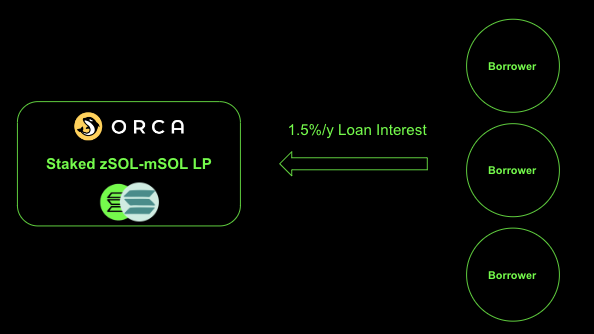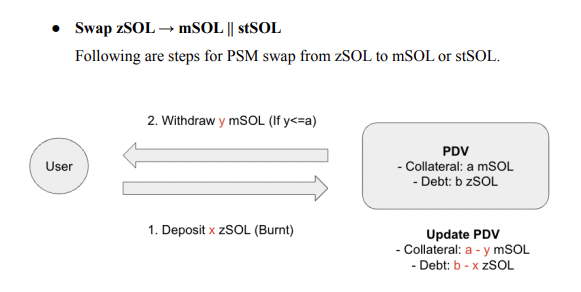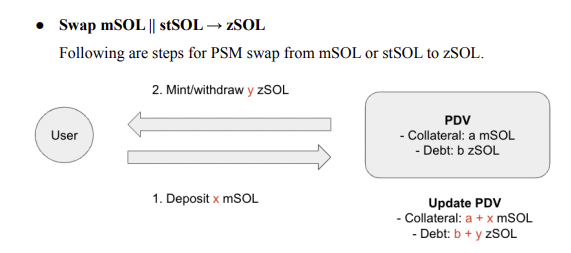Hi Chefs! I am Eric Lee from LP Finance. LP Finance is a synthetic asset issuance protocol getting prepared to launch our first synthetic asset, zSOL (Solana-pegged synth).
LP Finance expects zSOL to bring more adoption to mSOL with leveraged staking yields and allow mSOL to grow dominance among liquid staking protocols.
Intro to zSOL
Like all other synthetics, users can deposit collateral to mint zSOL. zSOL can be minted/borrowed at 1.5% APY stability fee, which allows users to create strategies such as:
-
Leverage liquid staking yields (mSOL - zSOL loop) up to 42%
-
Short sell (Using UXD as collateral)
-
Insurance on zSOL (Short zSOL advancing Solend Pool)
These strategies already exist and are mostly done via lending protocols, but LP Finance allows users to borrow at the lowest interest rate. However, in this case, immense selling pressure might cause zSOL to depeg from SOL.
Here are mechanisms which allow zSOL to maintain peg and scale better.
Incentivized Liquidity Providers
The most straightforward method to enhance peg-stability and scalability is to attract LPs. However, as CLMMs usually have low swap fees (≈0.01%), therefore liquidity mining rewards are provided. This is not a sustainable way to scale.
LP Finance rewards LPs with the collected stability fee from borrowers. In lending protocols, borrowers and lenders are counterparties. Therefore, borrowers pay lenders interest. In synthetic asset issuance protocol, there are no lenders. In this case, the counterparty would be LPs, which risk IL and provide liquidity to allow users to advance zSOL in different strategies.
Therefore, 1.5%/y stability fees are rewarded to LPs to secure peg-stability and allow both positions to proportionally scale. If the staked LP value is 5% of total zSOL debt, LPs will earn 30% APY on top of trade fees.
Treasury Management with mSOL (PDV)
Treasury management for the zSOL vault is done via mSOL to maximize treausry revenue. On LP Finance, there is a treasury vault, which is called Protocol Debt Vault (PDV). The basic concept is to acquire profitable debt positions, where mSOL as collateral and zSOL as debt. As zSOL stability fee is lower than the staking yields, this position would allow treasury to stack up yields continously.
PDV acquires debt positions via liquidation, typeless repayment, and peg-stability-module (PSM).
Details on how LP Finance DAO acquires profitable debt position to maximize revenue while incentivizing users here.
PSM
PSM on LP Finance involves PDV rather than an isolated pool. Here is a brief overview on how PSM works.
Basically PSM swaps can be comprehended as
- Adding mSOL collateral and borrowing zSOL on behalf of PDV
- Repaying zSOL on behalf of PDV and redeeming collateral
Details can be found here
How LP Finance Benefits Marinade Finance
LP Finance is highly dependent on liquid staking protocols like Marinade Finance and Lido to maximize protocol revenue and users’ yields. With leveraged strategies along with scaling solutions for zSOL, LP Finance would enhance mSOL adoption on Solana.
Additionally, LP Finance does accept stSOL (Lido staked SOL) as collateral, but treasury management program solely advances Marinade Finance. This would allow mSOL to grow dominance over other liquid staking protocols.
Grant Details
LP Finance is requesting 200k MNDE to boost the growth of LP Finance at the initial stage.
The cost is broken down into two components
- 30k MNDE: LM to staked zSOL-mSOL LPs
- 170k MNDE: Locked as NFT. Used for gauge votes and governance
LP Finance might experience high demand on leveraged liquid staking, which means zSOL sell pressure would be too high for initial liquidity to absorb. As zSOL is minted, staked LPs earn APR as follows.
lpStakingApr = (zSolBorrowedValue * 0.015) / stakedLpValue * 100
If $500k worth of zSOL is borrowed and staked LP value is $25k, the APR would be 30%. This is enough to motivate users to provide zSOL-mSOL liquidity, but borrowers could have a hard time until this happens.
Therefore, 30k MNDE (≈$2,000) would be provided to staked zSOL-mSOL LP on LP Finance for 2 months, which could bring initial boost to the pool, allowing more liquidity to access zSOL without large price impact after launch.
The zSOL-mSOL LP would be Nazare Finance’s LP, which rebalances Orca’s price range position to maximize capital efficiency and yields.
Conclusion
- LP Finance allows users to leverage staking yields (10x leverage) at better rate than lending protocols
- With Incentivized LPs, zSOL liquidity grows linearly with demand (low risk of depeg)
- LP Finance’s treasury management system (PDV) allows mSOL to grow dominance over other liquid staking protocols


